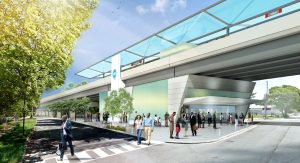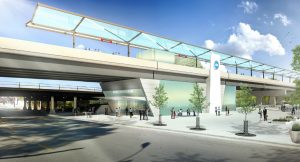CTA works to reduce demolition with Red Line extension update
By Igor Studenkov For Chronicle Media — March 5, 2018The Chicago Transit Authority took another step toward making the Red “L” Line extension to 130th Street a reality — even as it still unclear whether the project would receive the federal funding necessary to complete it.
The extension would largely follow the Union Pacific Railroad freight line right-of-way, reaching all the way to 130th Street, near the city’s southern edge. If completed, this will mark the first time any “L” line went south of 95th Street. And while that part of the city has some rail service via several Metra lines, the Red Line service would be cheaper, more frequent and, unlike the Metra lines, run 24/7.
On Jan. 26, 2018, the CTA released its plans for preferred alignment. While the transit agency previously considered putting the tracks either west of the UPRR tracks or east of them, CTA decided to do a combination of both. The “L” would be built west of the freight tracks up between I-57 highway and 108th Place, to east of the freight tracks between 108th Place and 119th Street, then following South Shore Line tracks the rest of the way. The CTA hopes that it would reduce the number of residences and businesses that would need to be demolished to make way for the “L” tracks while still giving the transit agency enough space to build stations and parking lots.
The idea of extending what is now known as the Red Line south of 95th Street has been discussed for almost as long as the 95th-Dan Ryan station has been open. But it wasn’t until the early 2000s that the plans gained traction as Developing Communities Project, a Rosemoor-based community organization, lobbied to get the project off the ground. It was eventually able to get a number of area organizations and politicians on board. In 2006, CTA officially started researching the project, narrowing down alignments. In Nov. 27, 2016, the transit agency released the preliminary version of the Environmental Impact Statement — one of the studies transit agencies are required to complete before it starts building any new transit projects.
The current plans call for the extension to continue south along the median Dan Ryan Expressway until it reaches the spot where it splits into the Bishop Ford Expressway and Ken Gray Expressway. It would follow the later expressway briefly until it reaches the UPRR freight line that runs along the eastern edge of Fernwood Parkway Park. At this point, the track would use the elevated structure similar to Orange “L’ Lines, continuing alongside the tracks as they go farther south before curbing southeast, toward Metra Electric tracks. Once the freight line crosses the Metra tracks, it turns south, but the “L” tracks keep going southeast, dropping to the ground level and following the South Shore Line right of way south of the tracks until it reaches 130th Street, at the northeast corner of Altgeld Gardens public housing development.
Aside from the 130th Street station, CTA plans to build stations at Michigan Avenue, 111th Street and 103rd Street. According to Robin Martel, the Senior Project Manager for the extension, each station will have a parking lot and a Kiss-n-Ride set-up similar to most Orange Line stations, where buses and cars can pull up right in front of the station entrance. And the transit agency hopes to build a rail yard on the currently partially vacant site south of the South Shore Line right of way, roughly between 119th Street and 127th streets.
Leah Mooney, CTA’s Director of Strategic Planning and Policy, told the Chronicle that Norfolk Southern railroad currently owns the rail yard site, and her employee wouldn’t be able to build anything there without its consent. She said that the two entities are currently negotiating the matter.
The neighborhoods south of 95th Street do get some rail service. The South Shore Line serves the Hegewisch neighborhood at the city’s southeastern tip. Metra Electric Line’s main branch serves Rosemoor, Roseland Pullman and West Pullman neighborhoods. Its Blue Island branch splits off at 115th Street, serving the southern portions of West Pullman. near the city’s south edge. The Rock Island District Line serves Beverly, Morgan Park and Washington Heights neighborhoods farther west.
There are, however, several issues that put the commuter train lines at a disadvantage. First, depending on the day of the week and time of day, the trains can run anywhere between once every hour and once every two hours. As previously reported by the Chronicle, in September 2017, Metra reduced the frequency along the Blue Line branch and removed evening service. By contrast, the Red Line is one of the busiest “L” lines, running once every two to five minutes during rush hour, once every six to seven minutes during off-peak hours and once every 15 minutes at night.
Second, there is the matter of fares. Metra and South Shore Line fares are both distance-based, so the farther the station is from downtown Chicago, the more the riders have to pay. Meanwhile, CTA has the same fares no matter how far the riders travel. Even after both Metra and CTA raised their fares earlier this year, CTA remains the cheaper of the two. For example, the standard “L” train fair is $2.25, while the fares for all Metra stations that serve 95th Street are $5.50. South Shore Line’s Hegewisch-to-Chicago fare is $6.25.

Lou Turner (left) talks to University of Illinois Urbana-Champaign urban planning students Nick Keeling (second from left), Tessa Ferraro (third from left) and Miles Churchill (right). (Photo by Igor Studenkov/for Chronicle Media)
According to CTA, extending the Red Lne to 130th Street would reduce commuting times for Far South Side residents taking public transit to work. The new train yard will allow it to add more frequent service. As CTA explains, one of the issues with that is the 98th Street train yard at the current south end of the line doesn’t have room to store any more trains. The new stations will also allow the transit agency to reduce traffic around 95th-Dan Ryan station. Under the current arrangements, it acts as a final stop for most of the CTA and Pace buses serving streets farther south. The extension will let CTA redirect some of the buses towards the newer stations closer to the streets they actually serve. For example, Route 103, which serves 103rd street, would stop at the new 103rd Street station.
On Feb. 13, the CTA held an open house at Gwendolyn Brooks College Preparatory Academy high school (250 E.111th St.) to let local residents and businesses know about the newly chosen track alignment and how it would affect the nearby properties. While choosing the mixed West/East alignment was designed to reduce the impact on homes and businesses, some properties would still be effected. According to the CTA presentation, a total of 236 properties would be affected one way or another. A total of 79 buildings would have to be demolished. This includes 59 residential buildings and 20 nonresidential buildings. For anyone who wanted to know more details, the CTA brought maps laying out which lots would be affected, as well lists of addresses for all of the affected properties. That said, the transit agency emphasized that the details may change as it completes the final version of the Environmental Impact Statement.
To address concerns about train noise, the CTA is planning to incorporate several noise-reducing features in the track and station structures. That included ensuring that the elevated tracks and station structures don’t have any gaps, adding sound barriers at the station and using continuous welded rail. As for vibrations, the presentation noted that UPRR freight trains that are already there cause more vibrations than lighter “L” trains.
Under Section 4(f) of the federal USDOT Act of 1966, if a public transit agency uses a public recreational area for a transit project, it must do something to make up for it. The presentation notes that, as part of the construction, CTA would be required to temporarily close off a portion of Fernwood Parkway. The transit agency has been working with the Chicago Park District to build a new park near the extension. They are currently looking at two possible locations — between 101st Street, Indiana Avenue, 102nd Street and Michigan Avenue, and on two lots east of the proposed Michigan Avenue station, south of Kensington Avenue.
Martel told the Chronicle that the CTA has been trying to be accommodating of other projects in the community. For example, when the transit agency learned about the proposal to build veterans housing near the 111th Street station location, it came up with ideas for how it could share the station parking with the development.
The CTA will now work on the final version of EIS and begin a preliminary engineering study. The engineering study is required in order to apply for federal funds. According to a Jan. 26 press release, the project is expected to cost around $2.3 billion, and CTA is hoping to get enough federal funds to cover at least $1 billion of it. According to Solani Tandon, the transit agency’s Senior Project Manager, the exact timeline will depend on when her employer is able to apply for federal funds.
“Once we enter project development, we have two years to finish the final EIS,” she said.
The open house was well-attended, with residents frequently crowding around display boards and asking questions about the projects in particular. The residents that spoke to the Chronicle that they supported the extension — even if they had concerns about some of the particulars.
Andrea Reed, the executive director of Greater Roseland Chamber of Commerce, said that she’s been involved with the project since 2009. She feels it would be a boon for residents and businesses alike.
“I think it’s a great opportunity,” she said. “Transit leads to job opportunities, and other opportunities, and it helps public safety.”
Resident Samone Taylor said that she felt the open house could have been handled better.
“I wish the alderman [Anthony Beale (9th Ward] was here,” she said. “CTA still needs to have some more meetings, especially so older people know what’s happening. They [especially] need to understand what’s going on.”
Lou Turner, a professor of African-American Studies at University of Illinois Urbana-Champaign, used to work as DCP’s Director of Research & Public Policy. He said that the Red Line extension would be a great asset to all of the communities it serves, especially Altgeld Gardens. As he noted, the neighborhood is separated from the rest of the city by industrial facilities to the north, the Little Calumet River to the west and south and the Bishop Ford Expressway to the east. Turner argued that an “L” line would be an improvement over Route 34 CTA bus, which is currently the neighborhood’s only transit link to the rest of the city.
That said, his endorsement had a caveat.
“One of the concerns with this project is that we don’t want to have unintended consequences — gentrification,” Turner said. “When you put public transit near affordable housing, it becomes very attractive and people who live here get displaced. So this is a concern, and the CTA and the city need to be aware of it. [The Red Line extension] is a good thing, people in the community definitely want it, but there is a concern.”
Get your free subscription of the Cook County digital edition
— CTA works to reduce demolition with Red Line extension update —









